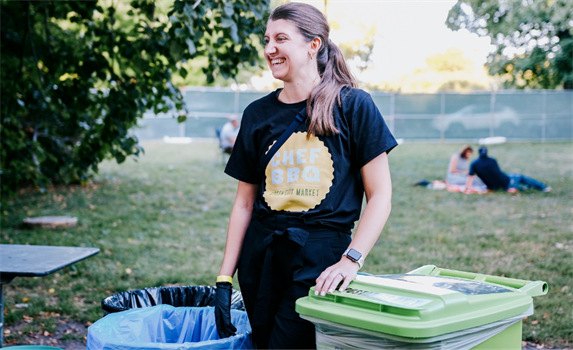Posted Mar 17, 2023

Our friends over at Zero Waste put together the following guide for reducing your food waste footprint. Keep reading for 9 essential tips.
No matter who you are, reducing food waste should be a priority. It’s crucial for slowing climate change and reducing your carbon footprint. It can also save families hundreds of dollars every year.
Below, read the top 9 tips for reducing your food waste footprint. That way, you can save the Earth and your hard-earned cash.
1. Get Educated
Knowledge is power! And you’re in the right place because the first step to reducing your food waste footprint is learning how and why.
The United States Department of Agriculture has recognized food waste as a significant ecological and social challenge. Learn about their initiatives, read this list, and see how you can adjust your habits to make an impact.
2. Source Sustainably
In other words, be mindful of where your food comes from. You’ll want to choose companies that uphold many of the practices below. As a rule, though, always try to shop local.
The closer to home, the better. Companies and farms based locally don’t ship their food products thousands of miles. That drastically cuts back on emissions. Your food also stays fresh longer.
3. Grow Your Own
There’s nothing closer to home than home itself! Growing your own food reduces your reliance on packaging, non-renewable transportation, and other unsustainable practices. Deforestation is also an issue, so the more plants there are, the better.
Most importantly, you and your family will get the opportunity to connect with and spend time in nature (hopefully together!) There’s something satisfying about planting, tending, and eating food you grew yourself.
Remember, it’s okay to start small. Plant a few kitchen herbs, then start some spring seeds. You can grow over time as you green your thumbs.
4. Make a Meal Plan (and Stick to It!)
Sometimes it isn’t about what you buy, but how much. Most of us have wandered through the market aisles, adding items to our shopping carts we don’t need.
By making a realistic meal plan, you don’t make those impulse purchases. You know what you will eat before your next trip and shop accordingly.
If sticking to a schedule doesn’t work for you, consider buying just enough food to feed your family seven breakfasts, lunches, dinners, and snacks each week. You can pick and choose each day and always have enough.
5. Prevent Spoilage
Meal plans help you reduce food waste, as does properly storing food. Learn which fruits and vegetables should be stored in the refrigerator, on the countertop, or in a dark space.
You can also take steps to prevent other foods from spoiling. Stop grains from going stale by keeping them in airtight containers, especially when the weather gets humid. Keep meat frozen until it’s time to cook, and use safe defrosting practices.
Speaking of freezing, you can keep all kinds of things in the freezer for months. Just do your research on how to do so safely.
6. Make Your Own
Processed foods are almost always worse than fresh. They take a lot of energy to produce, require plastic or other non-degradable packaging, and put toxins into our bodies and environments.
You can help sidestep all these issues by choosing homemade whenever you can. Instead of packaged cookies, spend a rainy afternoon whipping up a few batches. You can freeze them and enjoy a few at a time.
Once you start homemaking your staples, you’ll find tons you can do yourself, from pickles to sauces to ice cream and more.
7. Get Creative with Leftovers
Another primary source of food waste is tossing leftovers. The first thing you can do to cut down on this is only to cook what your family needs. Start paying attention to how much you consume and cut back accordingly.
You can also get creative with leftovers, especially if you pack lunch for yourself or others. Last night’s taco meat and dressings can be a taco salad for lunch. Roast a chicken on Sunday night and use the meat for sandwiches for a few days.
You can even freeze certain types of leftovers, like soup. That way, you can enjoy home-cooked food on busy days, too.
8. Use Your Scraps
Like leftovers, you can use much of your food scraps for other purposes. First, lots of them can be eaten, especially the skins of fruits and vegetables. You don’t even have to peel potatoes before you mash them!
You can freeze vegetable scraps, including onion and garlic skins, carrot and celery tops, and pepper stems, to boil down to a tasty homemade broth. Put your squeezed lemon rinds in your water bottle. Blend kale stems into a smoothie. The possibilities are endless.
9. Start Composting
Finally, for the things that you can’t salvage, start composting. When you compost, you allow certain food scraps and other waste to degrade and change naturally. As they do, they create fertilizer that gardeners (even yourself!) can use.
You don’t need outdoor space for composting. There are a number of indoor composters available. Alternatively, you can look into local composting co-ops who will come and pick up your scraps for you.
Small Changes Make a Big Impact
It may not seem like eating potato skins or keeping some fresh herbs in your kitchen will make a difference to the planet. But over time, small changes add up to a substantial overall effect.
Use the nine tips above to reduce your food waste footprint and become part of the movement.